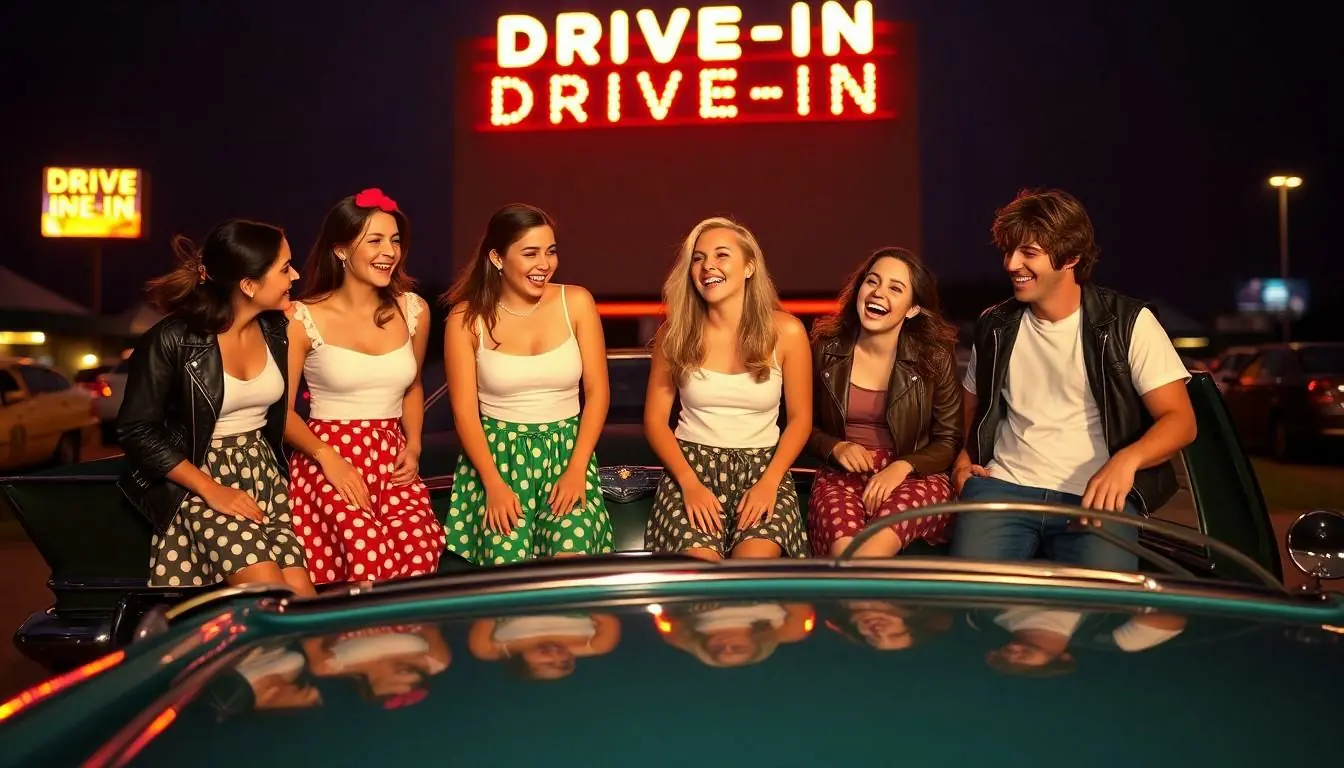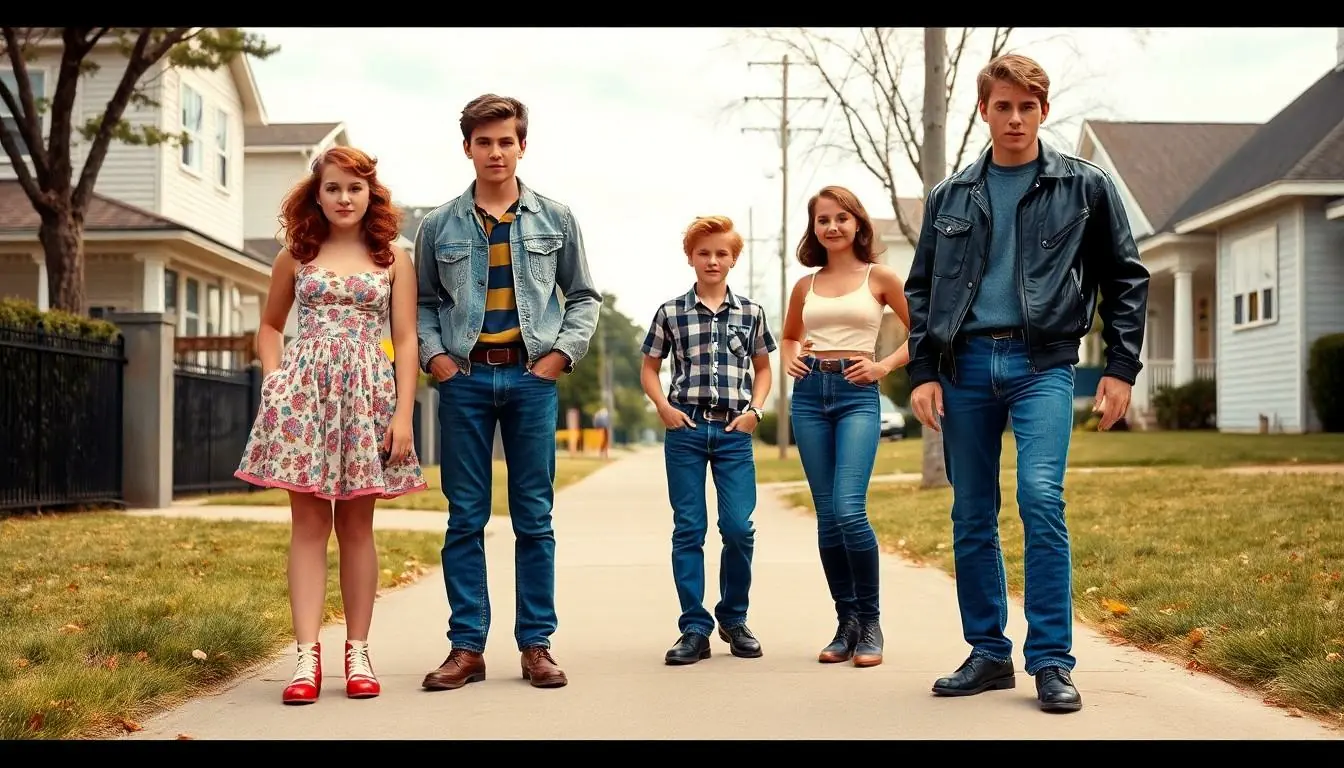Poodle skirts, leather jackets and rock ‘n’ roll created a perfect storm of rebellion in 1950s America. For the first time in history teenagers emerged as a distinct social group with their own fashion cultural identity and spending power. These young rebels with a cause transformed American society forever.
The post-war economic boom gave birth to a new phenomenon: teenage consumer culture. With disposable income in their pockets and newfound independence these adolescents flocked to drive-in movies cruised in hot rods and danced to the electrifying beats of Elvis Presley. Parents watched in horror as their clean-cut kids traded traditional values for greased-back hair bobby socks and an insatiable appetite for freedom.
Table of Contents
ToggleThe Rise of Teen Culture in 1950s America
The 1950s marked the first time teenagers emerged as a distinct social group with significant economic power. Post-war prosperity gave American teens an average weekly allowance of $10 ($108 in today’s money), creating a dedicated youth market worth $9 billion by 1959.
Teenagers developed their own fashion identity through specific clothing choices:
- Poodle skirts paired with saddle shoes for girls
- Leather jackets matched with white t-shirts for boys
- Bobby socks rolled precisely at the ankle
- Letterman jackets displaying school pride
Popular entertainment centered around youth-focused activities:
- Drive-in theaters attracted 2.5 million teenagers weekly
- Sock hops organized at high school gymnasiums
- Diners became social gathering spots
- Record stores hosted listening parties
| Teen Consumer Trends 1950s | Statistics |
|---|---|
| Average weekly allowance | $10 |
| Youth market value (1959) | $9 billion |
| Drive-in attendance | 2.5M/week |
| Record sales (1959) | $600M |
Rock ‘n’ roll music transformed teenage entertainment preferences. Record sales jumped from $200 million in 1954 to $600 million in 1959, led by artists like Elvis Presley Chuck Berry Dick Clark’s American Bandstand reached 20 million viewers daily, introducing new dance moves music trends.
Marketing companies targeted teenagers through specialized advertising campaigns. Corporations created teen-focused products:
- Seventeen magazine reached 2.5 million monthly readers
- TV shows featured teenage characters
- Fast food restaurants offered teen-friendly menus
- Clothing stores dedicated entire sections to youth fashion
This newly established teen culture created tension between generations as parents struggled with their children’s independence social choices entertainment preferences.
Fashion and Style Trends
Teen fashion in the 1950s reflected a sharp divide between clean-cut conformity and rebellious self-expression. Young people embraced distinct clothing styles that set them apart from their parents’ generation.
Poodle Skirts and Saddle Shoes
Girls’ fashion centered around the iconic poodle skirt, a circular felt skirt featuring appliqued poodles paired with crisp white blouses. Black and white saddle shoes complemented these outfits, along with bobby socks rolled precisely at the ankle. Sweater sets in pastel colors became a status symbol, with cashmere varieties costing $14.95. Peter Pan collars, cinched waists with wide belts, and pearlized button details completed the feminine look. Popular accessories included charm bracelets, cat-eye glasses, small shoulder bags and silk scarves tied at the neck.
Greaser Look and Leather Jackets
Boys adopted the greaser style, characterized by black leather motorcycle jackets costing $25 to $35. White t-shirts, often with rolled sleeves, became a symbol of youthful rebellion. Levi’s jeans sat low on the hips, with cuffs rolled to showcase polished boots or penny loafers. Hair styling took center stage with Brylcreem pomade creating the signature slicked-back look. Accessories included silver rings, wallet chains, and leather motorcycle boots. James Dean popularized this rebellious aesthetic in “Rebel Without a Cause,” making it a cultural phenomenon among teenage boys.
Music and Dance Crazes
American teenagers in the 1950s revolutionized popular culture through their music preferences and dance innovations, creating lasting cultural shifts that defined a generation.
The Birth of Rock and Roll
Rock and roll emerged as a transformative force in 1950s teenage culture, blending rhythm and blues with country music. Elvis Presley’s debut single “That’s All Right” in 1954 marked a pivotal moment, selling 20,000 copies in its first week. Chuck Berry’s “Maybellene” reached #1 on Billboard’s R&B chart in 1955, introducing guitar-driven rock to mainstream audiences. Radio stations dedicated to rock and roll programming increased from 250 in 1953 to 2,000 by 1958. Record companies recorded a 300% increase in teenage record purchases between 1954 and 1959. Artists like Jerry Lee Lewis, Little Richard, and Buddy Holly dominated teenage music preferences, with their records collectively selling over 50 million copies by 1959.
Popular Dance Styles
Teen dance styles evolved rapidly during the 1950s, reflecting the energetic nature of rock and roll music. The Jitterbug remained popular from the 1940s, with an estimated 8 million teenagers participating in dance competitions by 1955. The Bop emerged as a simplified swing dance, performed by 65% of American teenagers at sock hops. The Hand Jive gained widespread popularity after appearing on American Bandstand in 1957, reaching 20 million daily viewers. The Stroll became a group dance phenomenon in 1958, practiced at 75% of high school dances nationwide. Swing dancing competitions attracted 500,000 participants annually in major cities, demonstrating the enduring appeal of organized dance among 1950s teenagers.
| Dance Style | Year Introduced | Estimated Teen Participation |
|---|---|---|
| Jitterbug | 1940s-1950s | 8 million |
| The Bop | 1955 | 65% of teens |
| Hand Jive | 1957 | 20 million viewers |
| The Stroll | 1958 | 75% of school dances |
Teen Hangout Spots
Popular teenage hangout spots in the 1950s created dedicated spaces for adolescent socializing free from parental supervision. These locations became cultural landmarks that defined the era’s youth experience.
Drive-In Movies
Drive-in theaters attracted 2.5 million teenagers weekly by 1955, offering privacy in parked cars away from adult oversight. The outdoor venues featured double features for 50 cents per person, with snack bars serving popcorn, candy, and soft drinks. Theater lots accommodated 400-500 vehicles, equipped with individual speakers that hooked onto car windows. Popular films included “Rebel Without a Cause” and “Rock Around the Clock,” which drew packed crowds on weekend nights. Many drive-ins hosted special teen nights with pre-show entertainment, including live music performances and dance contests.
Malt Shops and Diners
Local diners transformed into teenage social hubs, complete with juke boxes playing the latest rock ‘n’ roll hits. Popular establishments featured chrome fixtures, neon signs, and vinyl booths where teens gathered over 25-cent hamburgers and 15-cent malts. Woolworth’s lunch counters served as meeting spots in 800 locations across America, while independent diners stayed open late to accommodate young customers. Typical menu items included french fries, chocolate sodas, and banana splits priced under $1. The installations of pay phones in these establishments enabled teenagers to coordinate social plans, making diners central to youth communication networks.
Dating and Social Customs
Dating rituals in the 1950s followed strict social protocols, marking a significant shift from casual dating to more formal courtship practices. The emergence of “going steady” became a defining characteristic of teenage romance during this era.
Going Steady
Going steady transformed teenage dating culture in the 1950s, with 47% of high school students reporting steady relationships by 1957. Couples exchanged class rings or special jewelry to symbolize their commitment, with girls wearing their boyfriend’s ring on a chain around their neck. Dating exclusively meant attending school dances together, sharing milkshakes at local diners, and coordinating matching outfits for social events. The practice created a social hierarchy in high schools, where steady couples often enjoyed elevated status among their peers.
Teen Social Rules
Formal dating etiquette governed teenage social interactions in the 1950s. Boys initiated date requests at least three days in advance. Parents enforced strict curfews, typically 10:30 PM on weeknights and 11:30 PM on weekends. Dating activities centered around school functions, drive-in movies, and chaperoned parties. Double dating proved popular, with 57% of teens preferring group outings in 1956. Girls maintained detailed dating records in their personal diaries, tracking their social calendar and romantic interests. The practice of “rating dates” became common, with teens scoring their dates on appearance, personality, and social status using a 10-point scale.
Rebellion and Youth Culture
The 1950s teenage rebellion manifested through distinct cultural expressions that challenged traditional values. Adolescents created unique identities through music, fashion, and social behaviors that set them apart from previous generations.
Hot Rod Culture
Hot rod culture emerged as a symbol of teenage rebellion, with customized cars serving as status symbols among young men. Enthusiasts modified standard vehicles by stripping excess weight, lowering suspensions, and enhancing engines to achieve speeds over 100 mph. Popular modifications included chrome accessories, flame paint jobs, and dual exhaust systems. Car clubs formed across America, with membership reaching 40,000 by 1955. These groups organized drag races at abandoned airfields, attracting crowds of 3,000+ spectators per event. Hot rod magazines like Hot Rod Monthly achieved circulation numbers of 300,000 copies per issue, demonstrating the widespread appeal of this automotive subculture.
Generation Gap
Parents expressed growing concern over their teenagers’ behaviors, creating unprecedented tension between generations. A 1957 Gallup poll revealed 67% of parents disapproved of rock ‘n’ roll music. Teen slang terms like “cool,” “drag,” and “hip” confused adults, while new dance styles sparked controversy. School administrators banned tight sweaters, rolled-up jeans, and leather jackets, viewing them as symbols of delinquency. Television shows portrayed rebellious teens through characters like James Dean in “Rebel Without a Cause,” attracting 2.8 million viewers. The widening cultural divide led to increased restrictions, with 75% of American cities implementing youth curfews by 1958.
Conclusion
The 1950s teenage revolution forever changed American society. Armed with unprecedented spending power young people carved out their own unique cultural identity through fashion music and social activities. From poodle skirts to rock ‘n’ roll their influence created a distinct youth market worth billions.
This transformative decade laid the foundation for modern teenage culture. Their rebellion against traditional values established teenagers as a powerful demographic that continues to shape consumer trends entertainment and social norms today. The cultural impact of 1950s teenagers remains evident in contemporary youth movements proving that their legacy endures well beyond their time.




